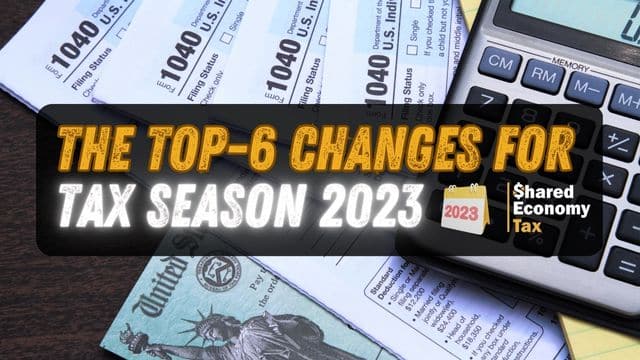
The tax code gets updated regularly, and this year is no exception. However, there are some particularly impactful changes coming this year thanks to recent legislation. Here are the 6 biggest changes to watch for on your 2023 taxes.
What to Expect for 2023 Taxes
The 2023 changes to tax laws include adjustments to tax brackets and rates, changes to eligibility requirements for certain deductions and credits, and updates to the tax code to reflect new technologies or business practices.
What Are the Biggest Tax Changes for 2023?
This year’s changes will affect you in different ways depending on your financial situation. We’ll take a look at some of the biggest changes for the year.
Section 179 Bonus Depreciation Phase Out Begins
Bonus depreciation gives businesses the option to deduct the cost of qualifying purchases immediately, rather than depreciating it. This deduction can help businesses reduce their tax liability and free up cash flow for other expenses.
Section 179’s allowance for bonus depreciation begins to phase out this year. As such, the maximum bonus rate will fall from 100% to 80%, and it will continue to decrease in subsequent years.
As of 2023, businesses cannot deduct the full cost of qualifying assets in the first year of ownership. Taxpayers who are accustomed to claiming bonus depreciation should plan for a reduced deduction and adjust budgets accordingly.
Tax Brackets Adjusted
Tax brackets adjust every year due to inflation and wage growth. For 2023, the IRS has increased most brackets to account for accelerated inflation. The new brackets will likely impact your 2023 tax bill.
The updated tax brackets for 2023 are as follows:
| Tax rate | Single | Head of household | Married filing jointly or qualifying widow | Married filing separately |
| 10% | $0 to $11,000 | $0 to $15,700 | $0 to $22,000 | $0 to $11,000 |
| 12% | $11,001 to $44,725 | $15,701 to $59,850 | $22,001 to $89,450 | $11,001 to $44,725 |
| 22% | $44,726 to $95,375 | $59,851 to $95,350 | $89,451 to $190,750 | $44,726 to $95,375 |
| 24% | $95,376 to $182,100 | $95,351 to $182,100 | $190,751 to $364,200 | $95,376 to $182,100 |
| 32% | $182,101 to $231,250 | $182,101 to $231,250 | $364,201 to $462,500 | $182,101 to $231,250 |
| 35% | $231,251 to $578,125 | $231,251 to $578,100 | $462,501 to $693,750 | $231,251 to $346,875 |
| 37% | $578,126 or more | $578,101 or more | $693,751 or more | $346,876 or more |
Standard Deduction Increased
In 2022, the standard deduction for a single taxpayer was $12,950. For 2023, it’s going to increase to $13,850.
The deduction for married-filing-jointly taxpayers also increased to $27,700 for 2023 from $25,900 the year before.
Taxpayers aged 65 or older were able to deduct an extra $1,400 per person in 2022, but the limit is increasing to $1,500 per person in 2023.
The vast majority of taxpayers claim the standard deduction on their taxes, but sometimes itemizing your deductions can result in greater savings. Your total deductible expenses may exceed the standard deduction limit, so it may be the better option. Consult with a tax pro for more details.
New Tax Incentives for Green Energy Investment
The Inflation Reduction Act created several new incentives for investments in sustainable technology.
Section 179D offers tax credits to commercial property owners who make energy-efficient improvements to their properties. This credit encourages property owners to make investments that will reduce their overall carbon footprint.
Qualified taxpayers can earn $5.00 per square foot for eligible improvements, like HVAC systems, lighting, and more. However, the deductions come with varying limits depending on the type of improvements.
Congress also boosted the electric vehicle tax credit to encourage investment in green vehicles. Under the new rules, there are no more limits on vehicles sold by manufacturers. Previously, this rule prevented taxpayers from claiming credits on popular vehicles from Tesla and other manufacturers.
The new rules also include clauses to support American manufacturing, and it reinstituted an expired credit for EV chargers. Taxpayers can earn a substantial credit on EV purchases under the new rules
Updated 1099K Limits Take Effect
The IRS now requires payment processors, like PayPal and Cash App, to issue 1099K Forms for businesses with annual transaction volumes of $600 or more. These regulations were supposed to take effect in 2022, but they were postponed due to industry pushback.
If your business uses platforms like these, you can expect to receive more 1099K forms this year. The regulation doesn’t extend to private use of these platforms by individuals, so you might not receive one if you’re not operating a business.
Individuals that receive a lot of payments from friends or family may receive a 1099-K in error. You should not ignore these forms if you receive them. Contact your payment processor about the mistake, and consult with a tax pro for additional steps.
Standard Mileage Rate Increase
The IRS also increased its standard mileage deduction for miles driven for business purposes. The rate for 2023 is $0.655 per mile; up from $0.585 at the beginning of last year.
The additional deduction provides valuable relief for businesses feeling the squeeze from higher fuel costs.
Key Takeaways for 2023 Taxes
Overall, the tax changes are good news for the majority of taxpayers. With inflation outpacing wages for many people, it’s good to know that taxes may take a smaller bite out of your tax take-home pay in 2023.
Questions About Taxes in 2023?
If you have questions about the tax changes for 2023, give us a shout! Shared Economy Tax specializes in small business and individual contractor taxes. Set up a one-on-one strategy session with one of our tax pros to get answers to your toughest tax questions and see how much you can save!